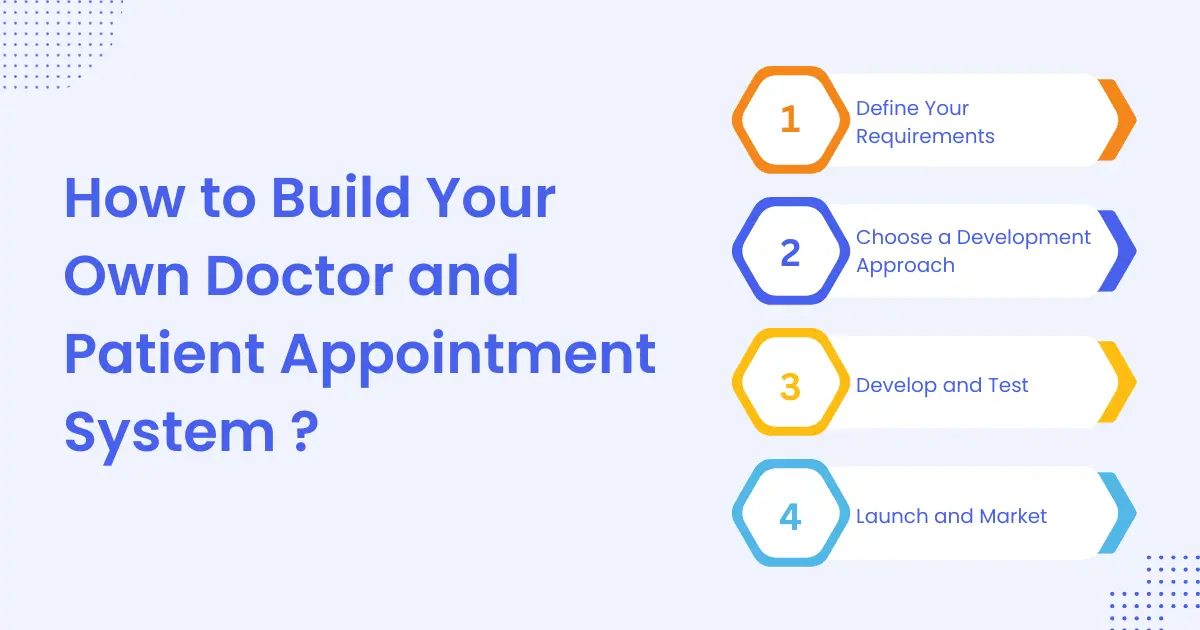Table of Contents
- 1. Understanding the Doctor and Patient Appointment System
- Key Features and Benefits
- Challenges and Considerations
- 2. Building Your Appointment System: A Step-by-Step Guide
- Step 1: Define Your Requirements
- Step 2: Choose a Development Approach
- Step 3: Develop and Test
- Step 4: Launch and Market
- 3. Future Trends in Healthcare Scheduling
- Conclusion
To compete with ever-shrinking time schedules, getting appointments from doctors and patients has really become a colossal task. However, when appropriate technology is available, such a process does not have to be cumbersome or inefficient in any way. Welcome to the doctor and patient appointment system. It is a powerful tool that helps with the organization of the schedule, increasing the number of patients not showing up to appointments and engaging the patient. Both for the common healthcare organization and the entering entrepreneur who may want to develop and introduce an appointment system into an organization, it is vital to learn how to go about it. Let’s discuss how you could do it from the concept stage to an actual fully functional prototype, particularly for a situation where you intend to start with a white-label appointment system.
1. Understanding the Doctor and Patient Appointment System
Key Features and Benefits
An appointment schedule for a doctor and patients is a scheduling mechanism to improve the scheduling of a doctor and patient. Here are some critical features and benefits: Here are some critical features and benefits:
-
Online Booking: Patients are able to book appointments online without having to access the doctor’s physical clinic at any time of the day.
-
Automated Reminders: Minimize the no-show cases with the use of auto-generated emails and text messages.
-
Real-Time Availability: Real-time management of schedules cuts down the problem of scheduling clashes, whereby physicians can update their timetable at will.
-
Integrated Payment Systems: Start with the consolidation of billing systems to incorporate payment facilities for services.
Example: Let’s imagine a large-scale family practice. Through a good appointment system, they are able to schedule their daily activities well, they are able to cancel appointments when necessary, and also they are in a position to give reminders to the patients leading to satisfaction in what they receive.
Challenges and Considerations
While the benefits are clear, developing a doctor and patient appointment system comes with challenges:
-
Data Security: On the same note, it is important to safeguard patient information in order to avoid any adverse outcome. HIPPA (Health Insurance Portability and Accountability Act) is one of the regulations that firms have to adhere to.
-
Integration: It must work in compliance with others through existing EHR and practice management systems.
2. Building Your Appointment System: A Step-by-Step Guide
Step 1: Define Your Requirements
Most importantly, before you begin developing the healthcare scheduling software, make sure to write down some of the features that should be on the software you wish to develop. Consider:
-
User Interface (UI) Design: Make it as comfortable as possible for the actual patient and the healthcare staff that is attending to the patient.
-
Functionality: Decide whether it will consist of telemedicine capabilities, patient gateways, or multi-lingual modes.
Step 2: Choose a Development Approach
You have two main routes: they prefer to start from a blank slate or use an appointment white label system. Here’s a brief comparison:
-
Custom Development: Advantages of flexibility but it provided less time and effort in comparison to its limitations.
-
White Label Solution: It gives you an instant turnkey package that you can take and make your own. This is mostly quicker and cheaper than any other method of advertising.
Step 3: Develop and Test
If you opt for custom development: If you opt for custom development: Prototype: It is almost always best to begin with a basic version in order to merely evaluate the heaviest part of the application.
-
Testing: It has been believed that more test cases should be conducted in a vigorous manner to help pinpoint the location of bugs.
-
Feedback: Collect users’ feedback so that adjustments can be done and changes can be made.
Example: An example is a small clinic that utilized a white-label solution to rapidly launch an appointment system. It was easy for them to match their branding on it and also interface it with their previous EHR system with little complications.
Step 4: Launch and Market
After this, you are now ready to go and it is now the time for launching your system. Ensure you:
-
Train Staff: Educate the user on how to best navigate the system.
-
Promote: Market the new system to would-be clients to ensure that they are aware of changes that have been made to it. To connect with the target market the key points of interest that have to be underscored include simplicity of use and compatibility.
3. Future Trends in Healthcare Scheduling
Emerging Technologies
The future of such software to be used in healthcare is rapidly growing. Key trends include:
-
AI and Machine Learning: AI can improve scheduling by attempting to anticipate patient needs and can reduce or eliminate time-consuming tasks.
-
Telehealth Integration: Just integrating the schedules with the telemedicine applications to present remote consultations.
Expert Opinions
Dr. Jane Smith, a healthcare technology expert, notes: “The integration of AI in appointment scheduling systems is not just a trend but a necessity for modern practices. It enhances efficiency and improves patient care.”
Conclusion
Creating a doctor and patient appointment system can significantly enhance the efficiency of healthcare practices while improving patient satisfaction. Whether you choose to build from scratch or use a white-label appointment system, understanding the development process and future trends will set you on the path to success. Ready to get started? Explore your options, plan thoroughly, and don’t hesitate to reach out for expert guidance. Dive into this opportunity to revolutionize healthcare scheduling and build a thriving business.
